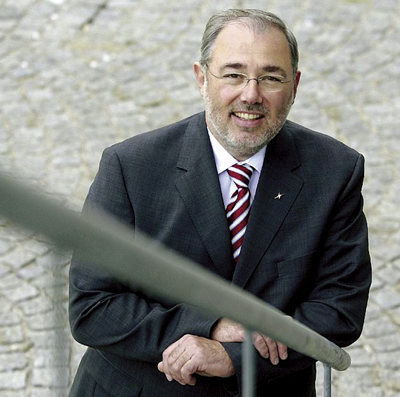Another record year for Krones
With a turnover of EUR 1.911 billion in 2006, profits increased by 22.3 percent to EUR 77.5 million. To make its shares more trade-able, a stock split at a ratio of one-for-three is planned.
“The winner is PET”, said Volker Kronseder, CEO of Krones at the company’s annual press conference which took place in Munich on 26 April. More than 80 percent of Krones’ turnover has been driven by PET, which in retrospect justifies the firm’s costly entry into the PET technology in 1997.
Recent forecasts predict that PET will continue to rise in popularity. While there were 205 billion beverage containers sold in 2003 made out of PET, this figure is to climb to 565 billion by 2015. That translates into a growth rate of 9 percent per annum. Over the same period, glass bottles and cans are expected to stagnate at 257 billion units (cans) and 290 billion units (glass bottles) respectively. Only cartons are believed to put up a fight yet with figures rising to 203 billion units in 2015 from 149 billion in 2007. Nevertheless, of the 1,380 billion beverage contains that will be sold in 2015 Volker Kronseder and his market researchers expect that 41 percent will be made out of PET.
The growing popularity of PET in Europe and North America, where the material has been replacing cartons as the beverage container of choice for juices and dairy products, has impacted Krones’ turnover significantly. In the financial year 2006, the world’s market leader in the field of beverage filling lines and packaging machinery upped its sales by 12.7 percent over the previous year to reach EUR 1.9 billion. Due to continuous improvement in productivity and business processes, the profits before tax increased by 20.3 percent to EUR 109.6 million. The net income for the year grew by 22.3 percent, hitting EUR 77.5 million (2006: EUR 63.4 million). It needs to be said, though, that profits after tax for 2006 have been influenced by exceptional factors. The resulting marginal tax rate reflects unique events resulting from a change in German Corporation Tax Law.
Sales in Germany climbed 26 percent to EUR 289 million or 15 percent of total sales. Although Krones does not see the benefits of globalising production and prefers to manufacture locally in Germany, its home market plays only a minor role. 37 percent of its sales originated in Europe with the bulk of sales being achieved on all other continents. In figures: Krones realised 48 percent of its turnover outside Europe. The highest growth rate among the industries Krones attributed to the food, chemical, pharmaceutical and cosmetics industries: +18 percent to EUR 441 million (or 23% of total sales). Soft drinks and water had the biggest share of sales with 46 percent or EUR 870 million. Turnover with brewers and distillers grew 4 percent to EUR 600 million in 2006 because of the fact, explained Volker Kronseder, that these industries launched fewer new products than other industries.
At the end of the year 2006, the Krones group employed 9,165 people, 1.5 percent more than in the previous year.
In 2006 Krones’ competitive environment has undergone serious changes with German rivals Huppmann having been bought by the GEA group and KHS by the Salzgitter AG. These takeovers should be seen as positive. For one, both GEA and Salzgitter are publicly-owned which means that the blood-letting price wars, which in the past have hurt all companies badly, may come to an end. Or as Volker Kronseder said: “Salzgitter AG and GEA as listed companies will have to earn money.” For another, these acquisitions prove that the beverage technology sector continues to be vibrant and attractive in the long-term.
Krones itself has been studying several takeover options but neither Volker Kronseder nor his CFO Hans-Jürgen Thaus could be drawn out which companies these were. Obviously, Krones hopes to expand its competency especially in the field of process technology. With competition heating up from low-cost producers in China, Krones believes its competitive advantage resides in the fact that it can offer solutions rather than just machinery and plant made out of iron or steel.
It is the emphasis on solutions that has made Krones’ number of employees go up. While a rise in employee figures would be considered negative – that’s an indication of how cynical the financial analysts have become – Krones insists that this is actually a good thing especially since this was coming from a company that has its base in a high-wage country like Germany. To put matters into perspective, Mr Thaus said that wages only contributed 12 percent to total production costs. That’s why it does not pay off for Krones to consider a relocation of production to, let’s say, India. Given the high investment in infrastructure and communication that ought to be included in any conscientious budgeting, India’s cost benefit is not really all that much to write home about.
Krones’ employees will be pleased to hear that.
For 2007 Krones forecasts a sales increase of between 7 percent and 12 percent. Moreover it hopes to raise its return on sales to 7 percent and its return on capital employed to 20 percent.
With a most recent share price in excess of EUR 139, the Krones share has hit a record high. To further stimulate trading of Krones stock and to make the shares even more attractive to investors, the Executive Board and the Supervisory Board of Krones will propose a stock split at a ratio of one-to-three to the Annual General Meeting of Shareholders taking place on 20 June 2007. The stockholders will receive two additional shares for each Krones share held. The necessary increase of share capital is to coincide with a capital increase from the company’s own resources.


